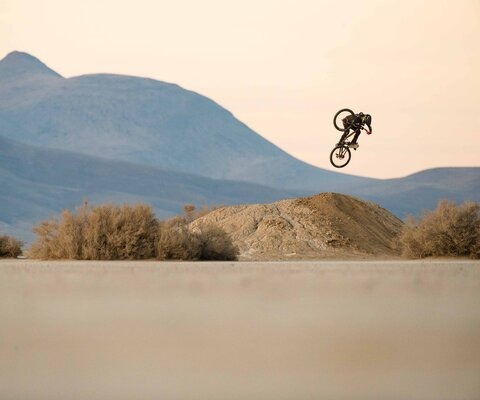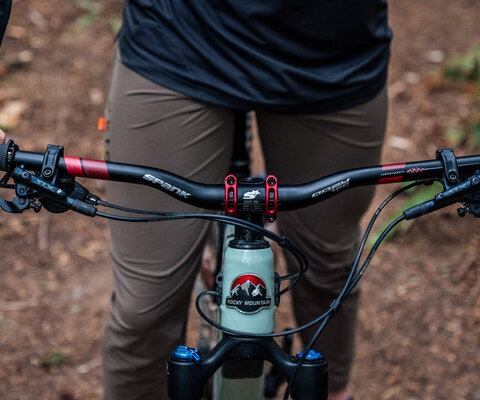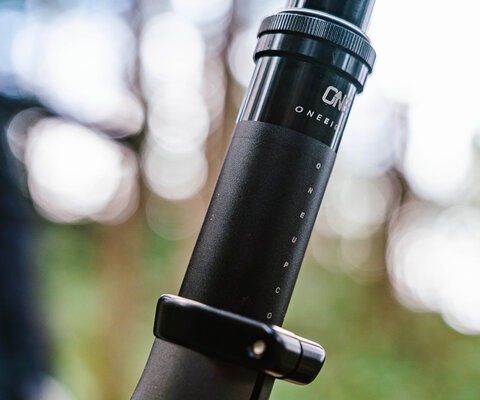
Let the Wrench Do the Talking - Mechanical Perfection with Nigel Reeve
Rotors mimic the honk of geese, wet from a trip through damp trail and washing. Rear hubs whirr and clack.
Pop-up tent canvas and banners flutter in the light breeze. Race commentary cuts through the music that echoes above the parking lot pit station at the World Cup at Mont Saint Anne, Quebec.
Amid these ambient sounds is the faint patter of tools being picked up and put down, the soft sequence of a chain spinning through a derailleur, the faint click of a shifter. Here, in the sanctuary of the Devinci Cycles race tent, a calm and crude Australian by the name of Nigel Reeve tends to the team’s bikes. As lead mechanic he’s responsible for keeping the stable finely tuned, a shadowy act in the grand spectacle of racing. At the elite level, each turn of the screw can have a massive impact, and the speed and safety of the fastest racers lies in the mechanic’s hands. Nigel’s abilities to keep his riders on the track and on the podium have taken him from a small town in Australia to a global journey of the world’s best mountain biking locales.
The first thing he says to me as we walk to grab a beer in the late afternoon is, “If you’re a downhill team mechanic, make sure you have a short piece of rope.” He’s referring to the fact that downhill bikes take a beating and keep a mechanic pinned in the pits, repairing or replacing any number of parts at any given time. At the World Cup level, they can feel the anxiety and stress of a big race as much as a rider corralled in the start gate. “Just before getting ready for race run there’s no margin for error, so, yeah, there’s definitely pressure, but I work much better under pressure,” Reeve says. “They say it’s human to make mistakes, but I’m literally being paid to not make a mistake.”
This translates into the perfect pinch of the brake lever, a gliding shift through the cassette, a buttery stroke in the suspension. These are the elements where a mechanic’s skill set and riding knowledge truly shows—and have potential consequences. “With one run left in the day, we can’t make any significant changes to the bike because it’s too close to the final race,” Reeve says about tuning Stevie Smith’s Devinci Wilson. “We wanted to change the shock tune and we weighed out the options then Stevie took a punt at something and rolled back to the tent just shaking his head. I’m just thinking ‘Oh fuck, I got it wrong.’ Then he says, ‘I just fucked my ankle.’ Part of my brain is like ‘Oh, sweet.’ Then the rest is like, ‘Fuck! That totally sucks!’”
Nigel grew up in Uralla, Australia, and you could say his craft started with toys and quickly evolved. “I had Meccano and Legos and all that stuff,” he says. “Then my dad gave me a car when I was 8 and said, ‘You can have that to drive around the paddock. But it needs this, this and this. The toolbox is in the shed.’ It was the same with bikes. I had to learn how to fix a bike if I wanted to ride a bike because there wasn’t the money to make it work again. It definitely forces you to work shit out yourself.”
For a boy who began working on cars before he was 10 years old, a bike may seem childishly simple. “The one toy I wanted was a moto, but my mom said, ‘No fucking way!’’’ Nigel says. “So I got a mountain bike instead. It’s the child-safe version. I guess I never outgrew it. I started racing, but when I realized I sucked, I still wanted to keep hanging around bikes, so I had to learn how to make a living out of it. I did two weeks of mechanical engineering at [university], but from the windows of the CAD class I could see the local trails. I could be riding my bike or I could be listening to this guy. I thought it was a great idea to go work in a bike shop instead.”
It’s a long path from the local bike shop to the pits of World Cup racing. There are the years of shop experience, the constant flow of new technologies, the industry connections and the drive to make it happen, all of which Nigel accumulated in time. “I bounced around bike shops for a while,” he says. “After three years I felt like I wasn’t really going anywhere in life, and I guess I was pretty frustrated.”
Things changed when a friend of Nigel’s came back from London with a connection at a bike shop in the city. Nigel rang up the owner, and ended up landing a job halfway across the globe.
For many Australians, venturing beyond the continent’s coasts and grand deserts is a difficult and expensive act, so it was a big deal when Nigel bought a ticket and made the flight to London. Things unfolded from there. “A mate and I were working at the shop in UK and decided to go to Morzine [France] on holiday for a few weeks,” he says. “One drunken night we said, ‘Yeah, we’ll do a season here next year.’ And we did.
“I went out there with a place to stay for one night and enough money to live for a week or have a ticket home—one of the two. The second day, I got a job at a bike and ski shop. I ended up living there for three years.”
Although powder and trail both thrive in the mountains, Nigel got tired of the winter season. Plus, he was becoming more talented at complex bike maintenance such as suspension, an area that quickly became one of his specialties. “I started doing suspension out of the back of the bike shop in Morzine. Since there was no one who could fix World Tour shocks in the area, it worked out that I could make more money doing that than changing tires.”
With a drive to keep his life orbiting around mountain biking, he went back to Australia and, in 2009, he and a friend started a suspension-servicing company called NS Dynamics. The business has grown to include more employees and now works with 150-200 bike shops across the country, offering 24-hour turnaround on suspension tunes and rebuilds.
Wheels and tires are the other more obvious components abused in gravity riding, and are also areas where Nigel possesses some secrets. This includes a dual air chamber system he developed in 2009, the details of which he keeps to himself. “Do you know how many flat tires Stevie [Smith] has had since I started working for him?” he asks. “One. And on that one he cut through the tread and into the rim. Pretty much anytime Stevie’s on the podium he flats, but the setup will always get him down.”
The most striking images of Reeve’s work are the riders’ shiny bikes barreling down the trail, lofting through the air or plowing through mud. Yet the mechanic’s touch is most visible the closer you look—and sometimes it’s there in what you don’t see. “One day I was thinking, ‘What if there’s a nonstick tape you could use to put on the downtube so all the mud would fall off?’” he says. “So I Googled it and found the right stuff. There are cool little solutions like that.”
While many of these tricks are of Nigel’s own creation, he’s not afraid to take advice from others. Earlier in the pits I noticed a small bit of Velcro stuck to the inside of the chain guide on Stevie’s bike. “It’s just stick-on Velcro that’s torched with a cigarette lighter,” he says. “That’s not actually my idea; it was Christian Schandl from MS Racing. I’m always the first to copy a great idea. You want to have the quietest bike on the track, and it can be embarrassing if your bike is going ‘clank kla clank clank.’”
Nigel’s attention to detail reaches past the practical; aesthetics can contribute to the mind game in less obvious ways. “There are some things I do purely to give Stevie confidence in my work,” he says. “His bike doesn’t have to be that clean, but when he shows up and there’s this brand-new-looking bike, it must be pretty nice.”
So what are the difficulties in mountain bike maintenance, according to Reeve? “I remember hearing a quote from [John] Tomac’s mechanic back in the day about what the hardest thing was and he said, ‘It’s getting all the stupid, lightweight shit to work properly,’” Reeve says. “We always have a certain amount of prototype or preproduction components and maybe just stuff that has inherent faults, so it’s overcoming that. Most of the time, we’re still obligated to use it, so it’s up to me to make it work.”
It might seem like an influential mechanic such as Nigel would be involved in the research and development side of things, but there’s often a separation between what’s happening in the pits and what’s happening on the computer screen in the design department. “At the end of the day, I’m just a bike mechanic,” he says. “It doesn’t go down very well if I walk into an R&D office in a pair of flip-flops and say something to a design engineer about his little baby.”
However, the realms of research and development and trail testing need to work in unison to create innovative bike parts. “A few years down the track working with the same people you do start to get somewhere, but it definitely takes a period of time for people to realize that you’re not just some punk off the street,” he says. “I’ve seen some of my ideas—the ones I’ve given to companies—go straight into production. To be honest, a ‘thanks’ would suffice, but with bigger companies you have people trying to take things as their own idea. I’ve learned to not give my ideas out so freely.”
The wrench has taken Nigel on a long tour beyond the trails he eagerly stared at from those university windows. He bases himself in Morzine during race season, central to all the European races and one of the best riding areas in the world, but still spends the off-season back in Auz. It’s a path that allows him to “live the pro life a bit,” but just as a professional racer’s career is limited by age and health, how long can a mechanic’s hands keep going? “I think working on bikes is harder to get out of than to get in, because if you’ve done it for a number of years, your life becomes arranged around this really weird lifestyle,” he says. “I thought about quitting for a few years. But I’m still here.”





